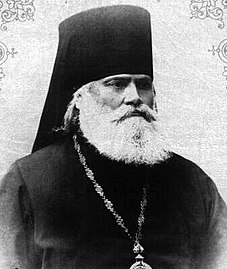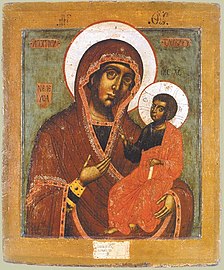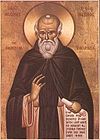August 22 (Eastern Orthodox liturgics)

August 21 - Eastern Orthodox liturgical calendar - August 23
All fixed commemorations below are observed on September 4 by Orthodox Churches on the Old Calendar.[note 1]
For August 22, Orthodox Churches on the Old Calendar commemorate the Saints listed on August 9.
Feasts[edit]
- Afterfeast of the Dormition.[1][note 2]
Saints[edit]
- Zoticus, Theoprepius (Bogolep), Acindynus, Severian, Zeno, and others, who suffered under Maximian (4th century)
- Hieromartyr Athanasius, Bishop of Tarsus in Cilicia, by beheading (c. 257)[1][4][6][7]
- Saint Anthusa of Seleucia (298), and Martyrs Charesimus and Neophytus (c. 253-259)[1][4][8][9]
- Martyrs Irenaeus, Or, and Oropsus.[4][10][note 3]
- Martyr Julian of Heliopolis in Syria (c. 362)[1]
- Saint Ariadne (515), daughter of Emperor Leo I.[1][4][11][note 4]
Pre-Schism Western saints[edit]
- Saint Antoninus of Rome, a converted executioner in Rome (186)[12][note 5]
- Saint Symphorian of Autun, martyred for refusing to sacrifice to a pagan goddess (2nd century)[1][12][14][note 6][note 7]
- Saint Hippolytus of Porto, Bishop of Porto in Italy, martyred by drowning under Alexander (236)[12][note 8]
- Hieromartyr Maurus, and Companions, a group of fifty martyrs in Rheims in France (260)[12][13]
- Saints Fabrician and Philibert, martyrs in Toledo in Spain.[12][13]
- Saints Martial, Saturninus, Epictetus, Maprilis, Felix and Companions, martyrs with St. Aurea of Ostia, honoured in Ostia, Italy (c. 300)[12][13]
- Virgin Martyr Eulalia of Barcelona (303)[1][14][15][16] (see also: December 10)
- Saint Timothy, a martyr in Rome under Diocletian (c. 306)[12][note 9][note 10]
- Saint Gunifort, a pilgrim, perhaps from England, who was martyred in Pavia in Italy.[12][13]
- Saint Sigfrid, Abbot of Wearmouth (c. 688)[1][12][14][17][note 11]
- Saint Ethelgitha, Abbess of a convent in Northumbria (c. 720)[12]
- Saint Andrew of Tuscany (c. 880)[12][note 12]
- Saint Arnulf of Eynesbury, saintly hermit, whose relics were venerated in Arnulphsbury or Eynesbury in Cambridgeshire, England (9th century)[12][note 13]
Post-Schism Orthodox saints[edit]
- Saint Bogolep of St. Paisius of Uglich Monastery (16th century)[1][14][18]
- Venerable Isaac I (Antimonov, the "Elder"), Schema-Archimandrite of Optina Monastery (1894)[1][14][19][20]
New martyrs and confessors[edit]
- Ephraim (Kuznetsov), Bishop of Selenginsk, and Priest John Vostorgov (1918)[14]
- Macarius (Gnevushev), Bishop of Orel, and Priests John Boyarshinov and Alexis Naumov (1918)[1][14][19][note 14]
- Theodore (Smirnov), Bishop of Penza, and with him Priests Basil Smirnov and Gabriel Archangelsky (1937)[1][14][19][note 15]
- John (Troyansky), Bishop of Veliki Luki (1937)[1][14][19][note 16]
- Alexis (Orlov), Archbishop of Omsk (1937)[1][14][19][note 17]
- Andrew (Ukhtomsky), Archbishop of Ufa and Menzelin (1937)[1][14]
- Hierotheus (Glazkov), Hieromonk, of Lyubim (Yaroslasvl) (1937)[1][14][19]
- John (Laba) and Hilarion (Tsurikov), Hieromonks, of Mirzoyan (Kazakhstan) (1937)[1][14][19]
- Alexander Ratkovsky, Michael Lyubertsev and Theodore Malyarovsky, Priests (1937)[14][19]
- New Hieromartyr Gorazd (Pavlík), Bishop of Prague, Bohemia and Moravo-Cilezsk, slain by Nazis (1942)[1][14]
Other commemorations[edit]
- Synaxis of Panagia Proussiotissa (Mother of God of Proussa) in Evrytania, Greece (c. 829–842)[21][note 18]
- Georgian Icon (Iveron Icon, Iverskaya) of the Most Holy Theotokos, at the Monastery of St. Alexis of Moscow (1650)[1][14][24][note 19]
Icon gallery[edit]
-
The martyrdom of Symphorian of Autun.
-
New Hieromartyr Macarius (Gnevushev), Bishop of Orel.
-
Georgian Icon of the Most Holy Theotokos (Iverskaya) (end of the 17th century).
Notes[edit]
- ^ The notation Old Style or (OS) is sometimes used to indicate a date in the Julian Calendar (which is used by churches on the "Old Calendar").
The notation New Style or (NS), indicates a date in the Revised Julian calendar (which is used by churches on the "New Calendar"). - ^ The Church continues to honor the passage of the Most Holy Theotokos from death to life. Just as Christ once dwelt in the virginal womb of His Mother, now He takes Her "to dwell in His courts."[2]
- ^ Or and Oropsus were tortured together with the priest Irenaeus. The three thrown into the fire, but a heavy rain suddenly extinguished the fire and the three witnesses were untouched by the flames. The prefect then gave the decree to behead them.
- ^ Her memory is preserved in the Synaxarion of Delahaye, as well as in Codex Oxon (Codex Biblioth. Bodleianae Oxon) t. III 16, and in Parisian Codex 1617.
- ^ "At Rome, St. Antoninus, martyr, who, openly declaring himself a Christian, was condemned to capital punishment by the judge Vitellius, and buried on the Aurelian road."[13]
- ^ A member of a senatorial family in Autun in France, he was martyred under Marcus Aurelius for refusing to sacrifice to a pagan goddess.
- ^ "At Autun, St. Symphorian, a martyr, in the time of the emperor Aurelian. Refusing to offer sacrifice to the idols, he was first scourged, then confined in prison, and finally ended his martyrdom by being beheaded."[13]
- ^ "At Porto, St. Hippolytus, bishop, most renowned for learning. Having gloriously confessed the faith, in the time of the emperor Alexander, he was bound hand and foot, precipitated into a deep ditch filled with water, and thus received the palm of martyrdom. His body was buried by the Christians at that place."[13]
- ^ His relics were enshrined in a chapel near the church of St Paul-outside-the-Walls and venerated there.
- ^ "At Rome, on the Ostian road, the birthday of the holy martyr Timothy. After he had been arrested by Tarquinius, prefect of the city, and kept for a long time in prison, as he refused to sacrifice to the idols, he was scourged three times, subjected to the most severe torments, and finally beheaded."[13]
- ^ A monk and disciple of St Benedict Biscop, he became Abbot of Wearmouth in England in 686. He was an example of monastic virtue.
- ^ Born in Ireland, he went to Rome as a pilgrim and settled in Fiesole in Italy and restored the monastery of San Martino in Mensula.
- ^ "ST. ARNULPH is said to have been greatly venerated, and the place of his sepulture to have been the centre of many miracles, before the devastation of the district by the Danes. We have, however, but very scanty information about his life. He is generally supposed to have been of British origin, and to have led a solitary and very austere life, on the borders of Huntingdonshire and Bedfordshire. On the same day, the 22nd August, an ancient French calendar commemorates St. Arnulph, Bishop, which has induced some writers to conjecture that the Saint of Arnulphsbury, or Eynebury, is the same as the French prelate, whose relics may have been translated to England."[17]
- ^ See: Макарий (Гневушев). Википедии. (Russian Wikipedia).
- ^ See: Феодор (Смирнов). Википедии. (Russian Wikipedia).
- ^ See: Иоанн (Троянский). Википедии. (Russian Wikipedia).
- ^ See: Алексий (Орлов). Википедии. (Russian Wikipedia).
- ^ The Icon of Panagia Proussiotissa (Mother of God of Proussa) was re-discovered near Karpenissi in Greece, after it had been lost during its transportation in 829 AD from Asia Minor to the mainland of Greece to save it from iconoclasm, during the period of iconoclastic Byzantine Emperor Theophilos (829–842).[22][23] According to holy tradition, this icon was painted by Saint Luke the Evangelist. The Monastery of Proussos in Karpenisi, Evrytania, Greece, was named after the Holy Icon of Panagia of Prousa. It was founded during this period on the site where the icon was re-discovered. Its feast day is 23 August (the Leavetaking of the Dormition of the Mother of God), and it is visited by crowds of pilgrims each year from 15 to 23 August to venerate the Icon of the All-Holy Mother of God of Prousa.
- ^ See: (in Russian) Грузинская икона Божией Матери. Википедии. (Russian Wikipedia).
References[edit]
- ^ a b c d e f g h i j k l m n o p q r s t August 22 / September 4. Orthodox Calendar (PRAVOSLAVIE.RU).
- ^ Afterfeast of the Dormition of the Mother of God. OCA - Lives of the Saints.
- ^ Great Synaxaristes: (in Greek) Ὁ Ἅγιος Ἀγαθόνικος ὁ Μάρτυρας καὶ οἱ σὺν αὐτῷ. 22 Αυγούστου. ΜΕΓΑΣ ΣΥΝΑΞΑΡΙΣΤΗΣ.
- ^ a b c d e (in Greek) Συναξαριστής. 22 Αυγούστου. ECCLESIA.GR. (H ΕΚΚΛΗΣΙΑ ΤΗΣ ΕΛΛΑΔΟΣ).
- ^ Martyr Agathonicus of Nicomedia, and others who suffered under Maximian. OCA - Lives of the Saints.
- ^ Great Synaxaristes: (in Greek) Ὁ Ὅσιος Ἀθανάσιος ὁ Ἱερομάρτυρας. 22 Αυγούστου. ΜΕΓΑΣ ΣΥΝΑΞΑΡΙΣΤΗΣ.
- ^ Hieromartyr Athanasius the Bishop of Tarsus in Cilicia. OCA - Lives of the Saints.
- ^ Great Synaxaristes: (in Greek) Ἡ Ὁσία Ἀνθοῦσα καὶ σὺν αὐτῇ. 22 Αυγούστου. ΜΕΓΑΣ ΣΥΝΑΞΑΡΙΣΤΗΣ.
- ^ Venerable Anthusa the Nun. OCA - Lives of the Saints.
- ^ Great Synaxaristes: (in Greek) Οἱ Ἅγιοι Εἰρηναῖος, Ὢρ καὶ Ὀρόψις οἱ Μάρτυρες. 22 Αυγούστου. ΜΕΓΑΣ ΣΥΝΑΞΑΡΙΣΤΗΣ.
- ^ Great Synaxaristes: (in Greek) Ἡ Ἁγία Ἀριάδνη ἡ Βασίλισσα. 22 Αυγούστου. ΜΕΓΑΣ ΣΥΝΑΞΑΡΙΣΤΗΣ.
- ^ a b c d e f g h i j k l August 22. Latin Saints of the Orthodox Patriarchate of Rome.
- ^ a b c d e f g h The Roman Martyrology. Transl. by the Archbishop of Baltimore. Last Edition, According to the Copy Printed at Rome in 1914. Revised Edition, with the Imprimatur of His Eminence Cardinal Gibbons. Baltimore: John Murphy Company, 1916. pp. 252-253.
- ^ a b c d e f g h i j k l m n o p September 4 / August 22. Holy Trinity Russian Orthodox Church (A parish of the Patriarchate of Moscow).
- ^ Virginmartyr Eulalia of Barcelona. OCA - Lives of the Saints.
- ^ RUSSIAN CHURCH OFFICIALLY ADDS SAINTS OF SPAIN, PORTUGAL TO LITURGICAL CALENDAR. Orthodox Christianity. January 4, 2019.
- ^ a b Rev. Richard Stanton. A Menology of England and Wales, or, Brief Memorials of the Ancient British and English Saints Arranged According to the Calendar, Together with the Martyrs of the 16th and 17th Centuries. London: Burns & Oates, 1892. pp. 404-410.
- ^ St Bogolep, disciple of St Paisius of Uglich. OCA - Lives of the Saints.
- ^ a b c d e f g h The Autonomous Orthodox Metropolia of Western Europe and the Americas (ROCOR). St. Hilarion Calendar of Saints for the year of our Lord 2004. St. Hilarion Press (Austin, TX). p. 62.
- ^ Venerable Isaac I of Optina. OCA - Lives of the Saints.
- ^ Great Synaxaristes: (in Greek) Σύναξις Ὑπεραγίας Θεοτόκου ἐν τῷ Πυρσῷ τῆς Εὐρυτανίας. 22 Αυγούστου. ΜΕΓΑΣ ΣΥΝΑΞΑΡΙΣΤΗΣ.
- ^ (in Greek) Χαραλαμπους Δ. Βασιλοπουλου ('Αρχιμανδρίτου). Θαυματα της Παναγιας. Εκδοσις 11η. Εκδοσεις Ορθοδοξου Τυπου, Αθηναι, 2000. pp. 42–44.
- ^ "THE HOLY ICON OF THE MOTHER OF GOD OF PROUSSA." The Living Word (Holy Orthodox Church in North America). Transl. Michael Maragoulias. Autumn 1998.
- ^ Icon of the Mother of God of Georgia. OCA - Lives of the Saints.
Sources[edit]
- August 22 / September 4. Orthodox Calendar (PRAVOSLAVIE.RU).
- September 4 / August 22. Holy Trinity Russian Orthodox Church (A parish of the Patriarchate of Moscow).
- August 22. OCA - The Lives of the Saints.
- The Autonomous Orthodox Metropolia of Western Europe and the Americas (ROCOR). St. Hilarion Calendar of Saints for the year of our Lord 2004. St. Hilarion Press (Austin, TX). p. 62.
- Menologion: The Twenty-Second Day of the Month of August. Orthodoxy in China.
- August 22. Latin Saints of the Orthodox Patriarchate of Rome.
- The Roman Martyrology. Transl. by the Archbishop of Baltimore. Last Edition, According to the Copy Printed at Rome in 1914. Revised Edition, with the Imprimatur of His Eminence Cardinal Gibbons. Baltimore: John Murphy Company, 1916. pp. 252–253.
- Rev. Richard Stanton. A Menology of England and Wales, or, Brief Memorials of the Ancient British and English Saints Arranged According to the Calendar, Together with the Martyrs of the 16th and 17th Centuries. London: Burns & Oates, 1892. pp. 404–410.
- Greek Sources
- Great Synaxaristes: (in Greek) 22 ΑΥΓΟΥΣΤΟΥ. ΜΕΓΑΣ ΣΥΝΑΞΑΡΙΣΤΗΣ.
- (in Greek) Συναξαριστής. 22 Αυγούστου. ECCLESIA.GR. (H ΕΚΚΛΗΣΙΑ ΤΗΣ ΕΛΛΑΔΟΣ).
- Russian Sources
- (in Russian) 4 сентября (22 августа). Православная Энциклопедия под редакцией Патриарха Московского и всея Руси Кирилла (электронная версия). (Orthodox Encyclopedia - Pravenc.ru).





